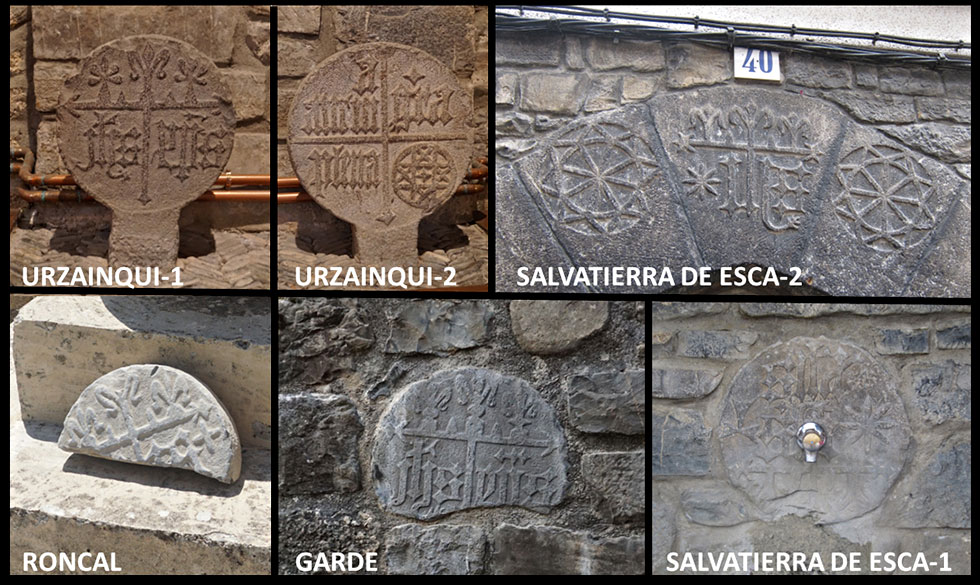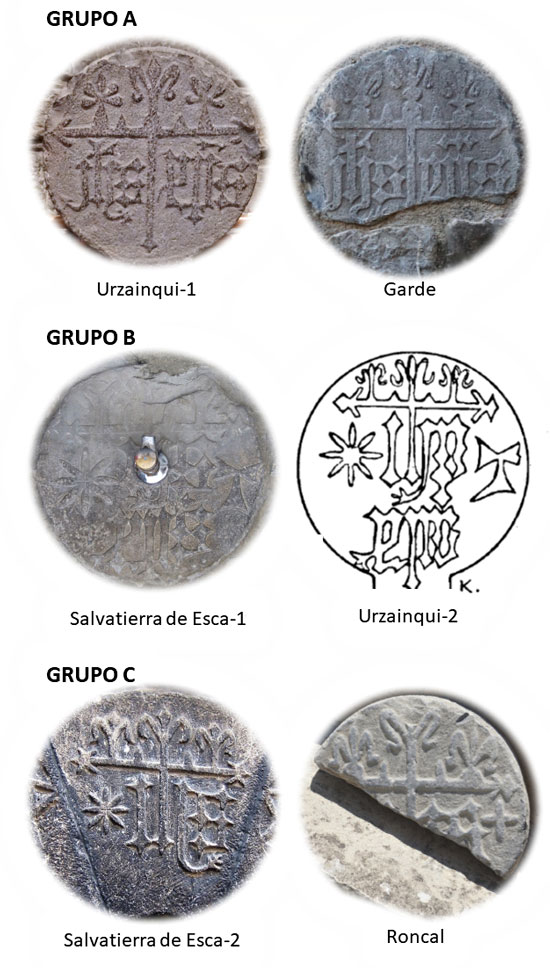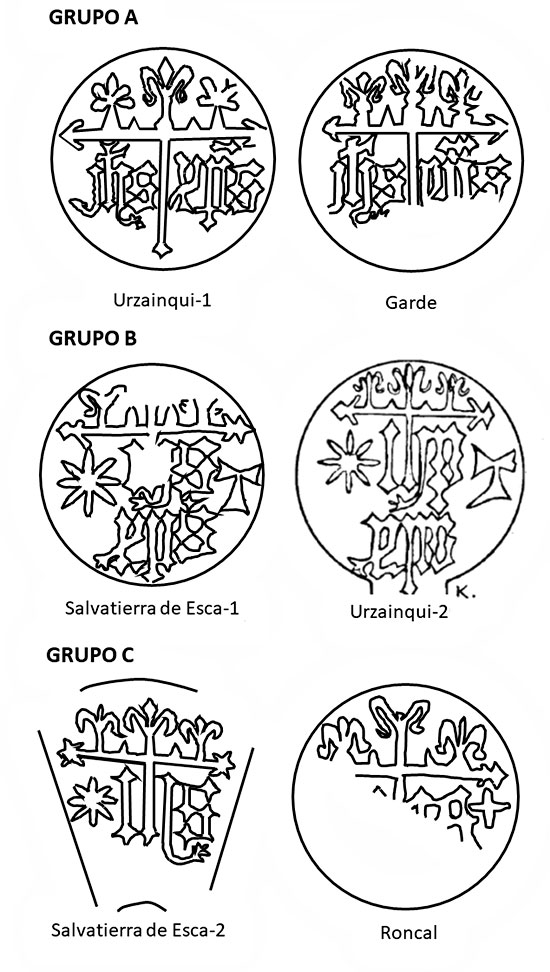The piece of the month of February 2023
A PURPOSE OF SOME RONCAL DISCOIDAL STELAE
José Ignacio Riezu Boj
University of Navarra
The stelae, inscriptions and decorative motifs on stone from the valleys of Roncal, Salazar, Navascués, Romanzado, Urraúl bajo and alto, Aibar and Orba were catalogued in 1965 by Tomás López Sellés, Casimiro Saralegui and José Cruchaga. The work was published in 1983 in Cuadernos de Etnología y Etnografía de Navarra, n.º 41-42, with the degree scroll "Piedras familiares y piedras de tumbas de Navarra". The authors located forty-one stelae in the Roncal valley. The village with more stelae was Vidangoz, with twenty, located in the cemetery attached to the church still active today. In Roncal they found nine, all in the old cemetery of the parish. In Uztarroz, two, and in Isaba, one, the three in the mountain. Finally, in Urzainqui, two stelae inside the church, although originally located outside. The authors did not locate stelae neither in Garde nor in Burgui. Most of these stelae are characterized by their coarseness and poor decoration, many of them with a simple cross engraved in the oval area. However, the two stelae found in Urzainqui stand out for their quality and epigraphic decoration. Later more stelae have been appearing in the valley, for example in Roncal, and after the cleaning of the old cemetery six other stelae or fragments of them have appeared.
The stelae we are talking about are Christian monolithic monuments generally with engravings that are erected on the ground with funerary functions. They are formed mostly by an elongated foot that is sunk in the ground and a discoidal head that finishes it where the inscriptions or engravings are located. Their origin dates back to the Bronze Age and they have been used by a variety of cultures. Christian stelae have been dated from the 8th and 9th centuries and used to mark probably important burials in the cemeteries attached to churches in the Middle Ages. Discoidal stelae ceased to be used when burials inside churches became widespread. In Navarre, this change took place in most cases at the beginning of the 16th century. Subsequently, the closure of the cemeteries attached to churches in the mid-19th century by government orders on the grounds of sanitary measures caused the disappearance of many of the medieval stelae that still persisted.
The study of the stelae of the Roncal valley and surroundings has allowed me to analyze a group of five stelae and a door core topic that present very similar characteristics and a invoice that I consider especially relevant given its magnificent quality, far superior to the rest of the stelae in the area. Four are located in Roncal municipalities and two in Salvatierra de Esca, a town in Zaragoza bordering downstream with the Roncal municipality of Burgui. These are the two Urzainqui stelae already mentioned by López Sellés et al; a stela embedded in a wall in Garde; a fragment of a stela in Roncal; a stela reused in a public source in Salvatierra de Esca; and the core topic of a doorway in the latter locality. All the stelae have a discoidal head of about 40 cm in diameter.

The six pieces are:
Urzainqui-1: Complete stela that preserves the foot and the discoidal head. It exhibits engravings only on one of its faces. sample engraved on one side of the head a tau.
Urzainqui-2: Complete stela that preserves the foot and the discoidal head. It has epigraphic engravings on both sides. Unfortunately, the face of interest is on the reverse and its placement against the altar of San Miguel in the parish church does not allow us to study its characteristics in detail. We have worked with the drawing of this face made by Casimiro Saralegui in the aforementioned publication.
Garde: Stele with only the head preserved. It is embedded in a staircase in the street that gives access to Casa Seisea. It was found in 1992 in the works of rebuilding the house, very close to the parish of Santiago.
Roncal: Fragmented stela, found in the cleaning of the old cemetery, which only preserves part of the discoidal head. It is the only one, besides those of Urzainqui, that remains exempt and only shows engravings in one of its faces.
Salvatierra de Esca-1: Stela with only the head preserved. It is embedded as part of a public source in the south exterior wall of the parish church of San Salvador. The spout of the source pierces the center of the stele, which is also placed upside down.
Salvatierra de Esca-2: core topic of the access door to building no. 40 on Calle Mayor. It also has two large rose windows on each side, in the voussoirs adjacent to core topic.
As we have already mentioned, this group of stelae and core topic have a very similar typology. All of them have a cross that divides, with its thin long arm, the field of the discoidal head in two halves. The short arm of the cross has in its upper part three fleurs-de-lis, a larger central one and two smaller lateral ones. On the short arms and between the fleurs-de-lis, two triangles are placed. The short arms of the cross end in an arrowhead. Between the long arm of the cross and in large lowercase Gothic letters, the monogram JHS is inscribed in all cases, and in four cases, a second monogram XPS. All the engravings are high relief of very good quality invoice with a high quality epigraphy.
In spite of the great homogeneity of the six pieces, we can group them into three pairs according to the issue and position of the Christological monograms they contain. We have called them group A, B and C, and they are practically the same. The group A shows the monograms placed one on each side of the cross, under the short arm. The epigraph JHP on the left and XPS on the right. The stelae Urzainqui-1 and Garde belong to this group . The group B also presents the two monograms, but placed one below the other. The upper IHS has the stick of the H coinciding with the long arm of the cross. The Salvatierra-1 and Urzainqui-2 stelae belong to this group . The group C only sample the monogram JHS, they lack the monogram XPS. Belong to this group the core topic Salvatierra-2 and the Roncal stela.

The three groups we have described show surprising coincidental details. Thus, in the stelae of group A, the short arm of the cross ends in a V-shaped point very different from the termination of the four pieces of group B and C. They also present what is probably an abbreviation sign above the P of the XPS anagram that does not appear on the other two specimens from group B. The two stelae from group A show the anagram JHS with J instead of I used in the rest of the pieces. In addition, the H on this group exhibits a crossed stick on the upstroke of the letter that we do not see on the rest. Finally, this group lacks the eight-pointed star that we find on the others. On the other hand, the group B presents a dot over the letter S of the monogram XPS, possible sign of abbreviation, which does not appear in the group A. Likewise, these stelae end the H in a branch that turns to the left, a turn that in the rest of the pieces is to the right. Finally, they show a tau to the right of the anagram IHS, which is only found in these specimens. Unfortunately, the fragmentation of the Roncal stela makes it difficult to compare the specimens from group C.

The monograms used on these stelae are invocations to the name of Jesus in Latin (IHS) and Greek (XPS); in both cases using the first two and last letters of his name Ih(esu)s in Latin or Χρ(ιστο)ς "Chr(isto)s" in Greek. The two monograms have been used since the 4th century as protective symbols. In the Roncal valley they proliferate on the keystones of many doors leading to houses. The authors of article themselves mention in this respect that "There is an extensive area of Navarra, which includes the valleys of Roncal and Salazar, Navascués, Romanzado, Urraúl Bajo and Alto, Lumbier, Sangüesa, Valles de Aibar and Orba and an extension of the Partido de Aoiz towards the west, with a great density of monograms of Jesus". The presence of these six pieces in such a close area induces us to propose the presence of a stonemasonry workshop of certain entity in this area with important knowledge of its official document. From the epigraphy used and the subject of the pieces worked, we can date this workshop to the end of the 15th century or the beginning of the 16th century.
